Aktualisiert: 2023-04-02
> findR *

In the first volume of the new series of the 'Encyclopedia of Plant Anatomy' dealing with tropical plants, the leaf structure of a tropical montane forest in Venezuela was investigated. The series is now continued with the description of the leaf anatomy of plants growing along the Venezuelan coastline. Emphasis is laid particularly on a coastal region the flora of which does not exist any more, as the plants had to give way to the construction of an airport.
Size and appearance of the plants is described, as well as the extent of their root systems. Phenology, dispersal and propagation are discussed. Leaf size and shape, leaf position and leaf movement are important features of the coastal plant communities. Equifaciality is considered a frequent characteristic of the strand vegetation. The C4-syndrome is frequently observed. Chloroplast migration within the sheath cells is described as a new phenomenon. Salt factor and succulence are discussed as well as leaf consistence. Density, position and size of stomata are studied. It is suggested that glandular hairs may have the function of water transportation in two opposite directions. The xeromorphic characteristics of the leaves are discussed and compared with those of plants from dryer regions in Venezuela. Finally, the four mangrove species indigenous to Venezuela are studied and structural variations in the leaves due to changing environmental conditions and salinity are discussed. An interpretation of the function of the slimy layer in the leaves of Rhizophora is attempted.
Emphasis is laid on the influence of ecological factors on the leaf structure in general.
Of interest to every botanist, specialists in forestry, paleobotanists, relevant research institutes, institutes for applied botany, institutes for wood research, agricultural colleges, science libraries.
Aktualisiert: 2022-05-18
> findR *
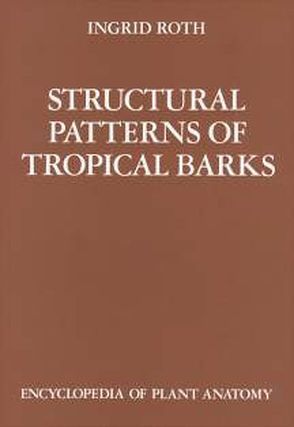
Although there already exists an enormous bibliography on wood anatomy, detailed studies of bark structure and especially of tropical barks, are very scarce and only deal with certain genera and species. Very little is known about the general bark structure in tropical trees, whether it is relatively uniform or diversified, and if it is subject to environmental factors; nothing is known of growth increments in tropical barks. Little is known of the bark structure of certain families and a comparison of bark structure from the taxonomic point of view is missing completely. It is unknown, whether bark structure may be used for identification in the field. Even the chemical composition of tropical barks is only little studied.
The main purpose of these studies was, therefore, to relate structural observations with taxonomic aspects, on the one hand, and with ecological considerations, on the other. By studying one family after the other (see ROTH, earlier publications), it was attempted to elaborate family characteristics in bark structure for anatomical and taxonomic use; to consider relations between outer bark appearance and inner structure; to facilitate tree identification in the field by observation of the gross anatomy; to study environmental influences on bark structure.
A comparative survey of the ecological aspects revealed certain structural bark properties which may be interpreted as 'adaptations' to a certain environment through selection. The principal result of these studies, however, culminates in the observation of an enormous richness of structures, forms, and patterns in the barks of tropical trees.
Some phylogenetic aspects respited from developmental studies as well as from a comparison of more primitive families with more advanced ones. A very extensive material was studied for the first time in a comparative way, following different main lines of interest, a large program lies still ahead of us: intensification of the studies and extension to a much larger number of species from very different environments in order to prove or abandon certain hypotheses presented in this book. Many of the tropical barks are also of economic interest and used in pharmacy or in the manufacturing industry.
It is hoped that the book will be used by plant anatomists, ecologists, taxonomists, forestry engineers and all people interested in the special properties of tropical barks.
All the illustrations included, drawings as well as photographs, are originals.
Aktualisiert: 2015-10-07
> findR *

In diesem Buch findet Napp-Zinns 'Entwicklungsgeschichtliche und topographische Anatomie des Angiospermenblattes' (1973/74) ihre Ergänzung. Hier behandelt er die Einflüsse der Außenfaktoren, der genetischen Information und der aus beiden resultierenden 'inneren Bedingungen' (KLEBS) auf die Struktur von Angiospermenblättern.
Die vorliegende erste von zwei Lieferungen ist den Beziehungen zwischen Außenfaktoren und Blattstruktur gewidmet. Im ersten Kapitel werden an Hand von Pflanzen ausgewählter Standorte -- von immerfeuchten Tropenwäldern über Mangroven und Wüsten bis hin zu Hochgebirgen und Laborräumen -- sogenannte komplexe Histosen besprochen; die übrigen Kapitel analysieren die wirksamen Faktoren im einzelnen: Licht (Intensität, Photoperiode, Wellenlänge), Temperatur, atmosphärische Faktoren, Wasser, Boden und Heterotrophie. Jedes Kapitel führt, soweit möglich, von dem in der Natur Entdeckten zum geplanten Experiment und trägt so der Forderung Rechnung, Anatomie und Physiologie wechselseitig füreinander nutzbar zu machen. Neben den wie immer ausgezeichneten Abbildungen des Autors sind viele quantitative Angaben in Tabellenform zusammengetragen worden.
Allein die jetzige Lieferung resümiert gegen 3000 Publikationen von etwa ebensovielen Autoren; sie stellt eine unerschöpfliche Fundgrube nicht nur für Pflanzenanatomen, Morphologen und Systematiker dar, sondern nicht minder für Stoffwechsel- und Entwicklungsphysiologen, Ökologen, Vegetationsgeographen sowie Fachleute für Umweltschutz, Pflanzen- und Tierernährung.
Aktualisiert: 2022-02-21
> findR *
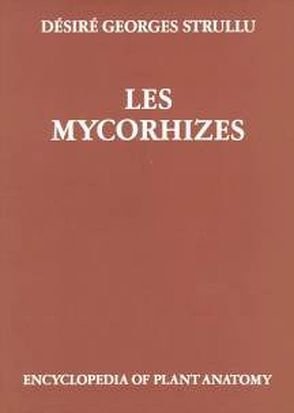
For the first time, the numerous publications regarding the anatomy, cytology and cytophysiology of mycorrhizas have not been gathered into a comprehensive treatise. It is made up according to the following pattern:
- a short first chapter dealing with the concept of mycorrhizas shows the diversity of the nomenclature and of the structures
- the second chapter presents the partners involved in mycorrhizal symbiosis; systematic positions, conditions of culture and of experimental reassociation are stated in a general way
- the third and fourth chapters respectively analyse the results which have been collected about the cytology of fungal elements and of root cells
- the fifth, sixth and seventh chapters put together the data regarding the cellular integration in ectomycorrhizas, endomycorrhizas and ectendomycorrhizas
Nowadays two groups present the most important stakes: ectomycorrhizas for sylviculture and the production of edible mushrooms, vesicular-arbuscular endomycorrhizas for agriculture and horticulture. The creation of new products corresponding to these stakes is limited by several problems. Our team endeavours to remove two of these; (1) the cloning of host-plants; if this cloning is not controlled, in the symbioses created the plant material displays genetic variability; (2) the in vitro culture of the endophytes, a limitating factor, particularly as regards Endogonaceae forming endomycorrhizas.
Aktualisiert: 2022-02-21
> findR *
Aktualisiert: 2023-04-04
> findR *
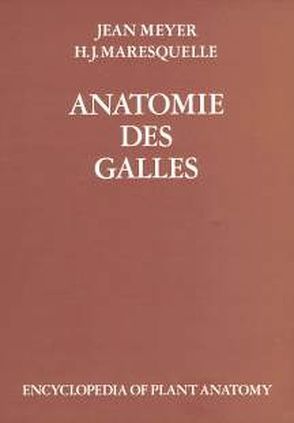
This work on the anatomy of galls (phytocecidia and zoocecidia) succeeds KÜSTER'S which appeared in 1930 in the same series, 'Handbuch der Pflanzenanatomie'. Despite the value of the latter, a new work was necessary to include recent findings and new theories in cecidology which have evolved in the last half century since publication of the first work. While retaining the essentials of the old work, the new work condenses past findings and leaves adequate scope for the presentation of new findings.
This new and comprehensive work is based on a bibliography of 493 works of reference and provides an index of gall-forming parasites comprising 438 species, genera and families and an index of hosts listing 347 names. It is magnificently and generously illustrated, with 519 figures, most of which are microphotographs taken with a light or electron microscope.
This work highlights the specific nature of gall-forming parasites and the organizing role played by cecidozoa, decisive for the anatomy of the gall hosting it -- the perfect adaptation of the plant to the parasite, permitting the realization of the latter's biological cycle and indispensable for conserving the gall-forming species. These structures are all described and illustrated in detail on the basis of the most recent works on this subject.
Aktualisiert: 2022-02-28
> findR *

Bei dieser zweiten und letzten Lieferung liegt das Schwergewicht auf dem ersten Teil, der den genetischen Grundlagen der Blattstruktur gewidmet ist. Ein wesentliches Ziel moderner Züchtungsforschung besteht bekanntlich in der Entwicklung resistenter (vor allem schädlingsresistenter) Pflanzen, welche eine Verminderung der Umweltbelastung durch Insektizide, Akarizide, Fungizide u. dgl. ermöglichen. Die unter solchen Gesichtspunkten relevanten anatomischen Daten zahlreicher Nutzpflanzen (Baumwoll-, Kartoffelsorten, Hauptgetreidearten etc.) werden hier ? quasi als eine Art Mitgift der klassischen Botanik bei einer Liaison mit der Gentechnologie ? ebenso gewissenhaft ausgebreitet wie die blattanatomischen Aspekte der Polyploidie, der Pfropfchimären oder der subspezifischen Taxa. Der zweite Textteil erörtert Beziehungen zwischen den ?inneren Bedingungen" (Klebs) und ihren experimentellen Veränderungen (z.B. durch Verletzungen, Zezidiozoen oder Phytohormone) auf der einen Seite sowie histogenetischen bzw. histologischen Erscheinungen auf der anderen. Das Literaturverzeichnis erschließt ca. 6000 Originalarbeiten, unter denen z.B. auch osteuropäische und chinesische angemessen berücksichtigt sind. Vier Register (zusammen ca. 170 Seiten) weisen die Namen von Autoren (über 6000 Personen!), Pflanzen und Tieren, geographische Bezeichnungen sowie die Behandlung einzelner Stichwörter nach. Mit der vorliegenden Lieferung ist Napp-Zinn's ?Blattanatomie der Angiospermen" abgeschlossen. In ihren insgesamt vier Lieferungen mit fast 3000 Seiten zieht sie das Fazit aus weit über 10 000 Publikationen. Damit liegt ein Standardwerk geschlossen vor, das auf Jahrzehnte hinaus in der botanischen Weltliteratur seinesgleichen suchen wird und an dem niemand mehr vorübergehen wird, der sich wissenschaftlich mit Blättern beschäftigt, sei es als Morphologe oder Ökologe, als Reiz-, Stoffwechsel- oder Entwicklungsphysiologe, als Umweltschützer oder Genetiker, als Systematiker oder Anatom.
Aktualisiert: 2015-10-07
> findR *
Aktualisiert: 2023-02-22
> findR *
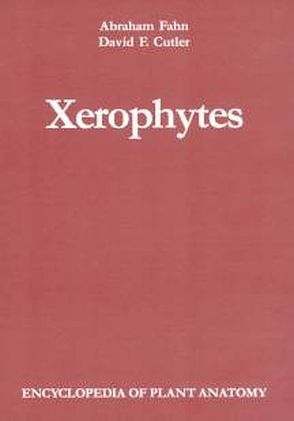
This book surveys current knowledge on the morphological and anatomical adaptations and survival strategies enabling plants to grow and complete their life cycles in arid, semi-arid and saline regions. These adaptations are numerous and diverse; when considered with associated physiological modifications it is clear that very few generalizations should be made about xerophytes. Here the authors have sought to organise information both from an extensive literature, and from their own research, so that it can be presented in a digestible form. To make the text concise, only selected examples of detailed anatomical descriptions are provided. There are many more in the literature; for example, in other volumes in this series (such as NAPP-ZINN, 1984, 1988), books dealing with systematic plant anatomy and a plethora of papers. The more significant of them are referred to in the text. The subject matter is organised in this way: the concept of adaptation to environment is followed by a brief consideration of arid regions and their floras; terms are defined; an account of various survival strategies is given. Next there is an account of the underlying anatomical/histological characters commonly found in the plants concerned, first in photosynthetic organs (mainly leaves) then in the plant axis (roots and stems). Adaptations to salinity are described. A brief summary section brings out the more important topics.
Aktualisiert: 2015-10-07
> findR *
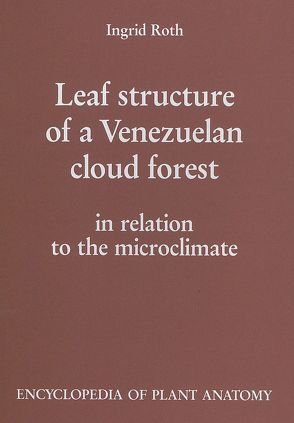
By the expansion of the population and the refinement of techniques, tropical vegetation is more and more endangered. Particularly the tropical forests are destroyed by the spreading of the indigenous agriculture as well as by the clearance of forests to obtain timber for various purposes. For thousands of years the indigenous population lived in a stable equilibrium with the environment, maintaining the existing ecosystem. In our modern times, however, the whole world seems to be involved in a rapid destruction of what has been left of the humid tropical forests. But our knowledge of an adequate management of these forests in order to maintain their natural characteristics as well as their productivity is very limited. Just as poor is our awareness of the real economic value of the humid tropical forests. However, exploited reasonably they may constantly yield forest products of different kinds, such as wood, fiber, resin, latex, cork, oil, medicinal drugs, chemical products and others.
Humid tropical forests, the richest manifestation of plant and animal life in the world, have evolved under relatively uniform environmental conditions so that an exuberant vegetation with a large variety of species but a small number of individuals per species has developed. It is estimated that 50--200 species may be found on a hectare, but only a few individuals of a given species. These 'living laboratories' represent the most important gene pool of the world. However, they may easily become extinct when exploited without care. Many species are endemic, many sensitive to environmental changes. Seeds have usually a short viability. Interrelations between plants and animals are of great importance, particularly in the dispersal of seeds and fruits.
It thus seemed worthwhile to dedicate a series of volumes of the Encyclopedia of Plant Anatomy to the structure of tropical plants to demonstrate the relationship between plant structure on the one hand, and environmental conditions on the other. A variety of ecological habitats in Venezuela have been studied by the present author in this connection. The present author has been teaching and doing research at Venezuelan universities for more than 20 years. Contacts have been maintained through many years and an exchange of Venezuelan and German scientists is still sustained. This interrelationship should be maintained for the benefit of future botanical studies in the neotropics. The cloud forest of the Parque Nacional Henri Pittier is one of the best known forests in Venezuela and probably in the whole of South America. It comprises a mountainous area of not less than 107800 ha. Its particular climate, the almost constant presence of mist and the occurrence of diffuse light generated a variety of structural adaptations of the 'mist shade plants', such as funnel-shaped photosynthetic cells, chloroplasts with thylakoids pointing in different directions, a larger chlorophyll a/b proportion, a weaker venation, formation of special water-storing tissues, a weaker radical system and many other peculiarities.
Because it is so well known in the scientific world, we decided to begin our series with the cloud forest of Rancho Grande.
Aktualisiert: 2022-05-11
> findR *
MEHR ANZEIGEN
Bücher von Tischler, G
Sie suchen ein Buch oder Publikation vonTischler, G ? Bei Buch findr finden Sie alle Bücher Tischler, G.
Entdecken Sie neue Bücher oder Klassiker für Sie selbst oder zum Verschenken. Buch findr hat zahlreiche Bücher
von Tischler, G im Sortiment. Nehmen Sie sich Zeit zum Stöbern und finden Sie das passende Buch oder die
Publiketion für Ihr Lesevergnügen oder Ihr Interessensgebiet. Stöbern Sie durch unser Angebot und finden Sie aus
unserer großen Auswahl das Buch, das Ihnen zusagt. Bei Buch findr finden Sie Romane, Ratgeber, wissenschaftliche und
populärwissenschaftliche Bücher uvm. Bestellen Sie Ihr Buch zu Ihrem Thema einfach online und lassen Sie es sich
bequem nach Hause schicken. Wir wünschen Ihnen schöne und entspannte Lesemomente mit Ihrem Buch
von Tischler, G .
Tischler, G - Große Auswahl an Publikationen bei Buch findr
Bei uns finden Sie Bücher aller beliebter Autoren, Neuerscheinungen, Bestseller genauso wie alte Schätze. Bücher
von Tischler, G die Ihre Fantasie anregen und Bücher, die Sie weiterbilden und Ihnen wissenschaftliche Fakten
vermitteln. Ganz nach Ihrem Geschmack ist das passende Buch für Sie dabei. Finden Sie eine große Auswahl Bücher
verschiedenster Genres, Verlage, Schlagworte Genre bei Buchfindr:
Unser Repertoire umfasst Bücher von
- Tischlinger, Helmut
- Tischlinger, Martina
- Tischmacher, Hans
- Tischmacher, Jürgen
- Tischmacher, Jürgen
- Tischmann, Frank
- Tischmeyer, Christoph
- Tischmeyer, Frank
- Tischner, Christian
- Tischner, Christian K.
Sie haben viele Möglichkeiten bei Buch findr die passenden Bücher für Ihr Lesevergnügen zu entdecken. Nutzen Sie
unsere Suchfunktionen, um zu stöbern und für Sie interessante Bücher in den unterschiedlichen Genres und Kategorien
zu finden. Neben Büchern von Tischler, G und Büchern aus verschiedenen Kategorien finden Sie schnell und
einfach auch eine Auflistung thematisch passender Publikationen. Probieren Sie es aus, legen Sie jetzt los! Ihrem
Lesevergnügen steht nichts im Wege. Nutzen Sie die Vorteile Ihre Bücher online zu kaufen und bekommen Sie die
bestellten Bücher schnell und bequem zugestellt. Nehmen Sie sich die Zeit, online die Bücher Ihrer Wahl anzulesen,
Buchempfehlungen und Rezensionen zu studieren, Informationen zu Autoren zu lesen. Viel Spaß beim Lesen wünscht Ihnen
das Team von Buchfindr.










